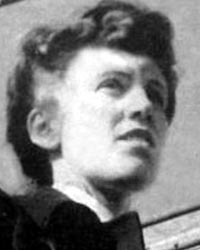
Lettice Curtis (*-*)
Those who were part of it believe the Air Transport Auxiliary (ATA) was a crucial contribution to the war effort, but the male and female civilians recruited to transport war planes, from factories to air bases all over Britain, during the Second World War have been all but forgotten by the history books. The incredible work of this small but vital movement, which had its headquarters at White Waltham airfield, is celebrated in The ATA Collection, an exhibition of rarely seen archive material, at the Maidenhead Heritage Centre from Wednesday.
The ATA was established in the summer of 1939 for communications work, completing such tasks as the transportation of government ministers. Later its remit expanded to include flying new fighter planes from factories. The idea was to free RAF pilots for operational duties by using civilian private pilot's licence-holders instead. The 1,300 ATA pilots operated from 14 'ferry pools' scattered all over the country, of which White Waltham was Number One. Pilots would be flown from these airfields in 'air ferries' to nearby factories where they would pick up aeroplanes fresh from the conveyor belt and fly them, usually solo and without navigational aids, to RAF bases as far north as Lossiemouth in Scotland. In July, 1940, Lettice Curtis was working as a pilot for a survey company when she became one of the second group of women to be recruited by the ATA. She was first based at Hatfield, where she flew Tiger Moths, before being moved to Hamble and finally White Waltham.
"People forget how serious the war was in 1941. Ships were being sunk and towns were being bombed," said Lettice, who now lives in Twyford. "They were building more and more aircraft and it was important they were got away from the factories, because they were liable to be bombed."ATA pilots worked ceaselessly to move incredible numbers of planes, including 57,000 Spitfires. Planes moved by Lettice included Hurricanes, Typhoons, Tempests, Halifax's, Wellingtons and Warwicks. Although she maintains the work was 'much simpler flying than the RAF', because in involved a straight, level journey between two points, Lettice admitted the job was not without its complications.
"Very often you didn't get to your destination in one go. "You navigated by looking at the ground. If the weather was bad and you couldn't get there, you landed at a suitable airfield."In days before the clean air act came into force, cities would be blotted out completely from the air by smog.
"In nice weather it was easy, but when the weather was bad it took a lot of concentration. "If the weather was particularly bad, you just had to hang around until it got better."Despite some people's resistance to the idea of women flying large, fast aircraft, Lettice saw it as 'just a job'.
"You didn't stop and think whether it was daunting. It was just flying. "People loved flying and wanted to continue. If you did badly, you would be terrified of being thrown out. "It was only one job in the war. People were doing all sorts of things."
The ATA - Women with Wings : Part 5 - Classes and closure which says in part... Training in a variety of aircraft became necessary and as a result of this the ATA Conversion School, where pilots would be trained to fly various classes of aircraft, was developed. The various types flown by the ATA were organised into different categories:
British Air Transport Auxiliary: The First Civil Ferry Pool by Lettice Curtis In 1937, seriously concerned about the effect on the country of the air raids, the Government passed an Air Raids Precaution Act. The main worry concerned poison gas and incendiary bombs. They were so conveyed that poison gas would be used that pillar-boxes were painted with yellow, gas indicating paint. In 1938, 35 million gas masks were distributed and Sir John Anderson, remembered for the air-raid shelter that still bears his name, was appointed to take charge of civil defense. With conscription in force in Germany, it was already anticipated that war would come in the autumn of 1939. It was against this that Colonel (later Sir Francis) Shelmerdine, Director of Civil Aviation at the Air Ministry devised a scheme for using private pilots, ineligible for active service, for internal communication work. But to pay these pilots, treasury approval was needed and approval was not given until the summer of 1939, when it was given on condition that the Reserve was administrated by British Overseas Airways which was in the process of being set up by merging Imperial Airways with pre-war British Airways. ...more
|
© Copyright 1999-2002 CTIE - All Rights Reserved - Caution |
